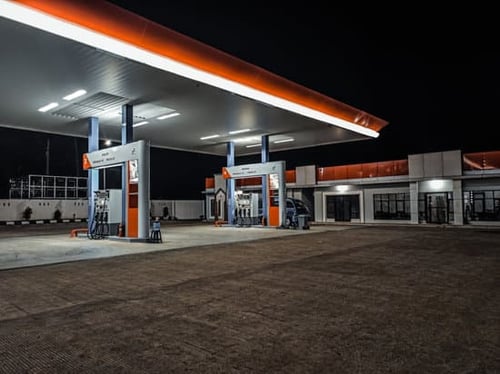Shift in C-Stores from 2000s to Now: A Transformation in Convenience
.webp?width=900&name=tl(15).webp)
The convenience store industry has undergone a remarkable transformation since the turn of the millennium.
From evolving consumer expectations to technological advancements, convenience stores – commonly known as C-stores -- have adapted to meet changing demands while maintaining their core promise of convenience.
Once primarily associated with quick snacks and fuel, these establishments have evolved into multifaceted retail hubs that cater to a wide variety of consumer needs, especially since the pandemic.
“There’s no question gasoline is a massive revenue driver for C-stores. But with the advent of the COVID-19 pandemic, C-stores became a lifeline for food, snacks and other items in a quick and easy format. And some companies are focused on being seen as a restaurant just as much as — if not more than — a gas station,” wrote C-Store Dive editor Jessica Loder in July 2024. “Add in the looming changeover to electric vehicles, which threatens to put a big hole in fuel sales, and it’s understandable why some companies increasingly emphasize inside sales.”
Let's explore the key shifts that have reshaped the C-store landscape over the past two decades, highlighting technological innovations, signage advancements, product offerings, and store layouts.
Healthy Choices: Expansion of Food Service Offerings
In the early 2000s, C-stores were primarily known for selling packaged snacks, beverages, and tobacco products. Today, they've become formidable competitors in the quick-service food industry.
Many C-stores now offer:
- Made-to-order meals.
- Gourmet coffee and specialty beverages.
- Sit-down dining areas.
- Expanded grocery sections with organic and local products.
This shift has been driven by consumer demand for healthier, higher-quality food options on the go. Stores have invested in kitchen equipment, trained staff, and partnered with popular food brands to elevate their offerings.
As consumer preferences have shifted towards healthier lifestyles, C-stores have adapted their product offerings accordingly. Many stores now stock:
- Fresh fruits and vegetables.
- Organic snacks and beverages.
- Plant-based alternatives.
- Protein-rich options.
- Low-sugar and sugar-free products.
The expansion into foodservice has not only increased foot traffic but also significantly boosted profit margins for C-stores. As traditional revenue streams like tobacco sales have declined, food has become a crucial component of the c-store business model.
Technological Integration
The digital revolution has dramatically impacted C-store operations and customer experiences. Key technological advancements include:
- Mobile payment and other contactless options.
- Self-checkout kiosks for quick checkouts.
- Loyalty programs and apps with personalized offers.
- Digital menu boards.
- Advanced inventory management systems.
- Data analytics for personalized marketing.
These technologies have streamlined operations, reduced wait times, and allowed C-stores to offer more personalized experiences to their customers.
“While the pandemic helped expedite changes in lifestyle and shopping behavior, consumers were already adapting to a variety of technologies designed to make shopping easier. Things like mobile ordering, curbside pickup, and delivery have now become commonplace as consumers have adapted and plan to continue to use these platforms,” says C-store supplier Ice Robotics. “In addition, working from home, and a greater focus on health and wellbeing are also greater points of concern for today’s consumer—driving them to change their shopping habits. For convenience stores, this means restructuring how they provide goods and services and the types of goods and services they will offer, to bring customers back into the store.”
Fuel and Electric Vehicle Services
While fuel sales remain a significant part of the C-store business, the industry has had to adapt to changing automotive trends. Many stores now offer:
- Alternative fuels like E85 and biodiesel
- Electric vehicle charging stations
- Enhanced forecourt services
The addition of EV charging stations has created new opportunities for C-stores to engage customers for longer periods, potentially increasing in-store sales.
These initiatives not only appeal to environmentally conscious consumers but also often result in long-term cost savings for store operators.
“For convenience stores, the rollout of electronic vehicle (EV) charging stations promises to more than offset the loss of foot traffic from declining gas and tobacco sales and further accelerate recent success with grab-and-go food offerings,” writes Tom Ryan in Retail Wire.
Evolution of Store Design and Layout
The physical appearance and layout of C-stores have undergone significant changes since the 2000s. Modern C-stores often feature:
- Larger footprints (averaging 3,500 square feet compared to 2,500 in the early 2000s)
- Open floor plans for improved navigation
- Enhanced lighting and more windows for natural light
- Dedicated spaces for fresh food preparation and display.
- Interactive displays provide customers with information and promotional offers.
- Comfortable seating areas for dining or working.
- Growing emphasis on eco-friendly store designs, including energy-efficient lighting and sustainable materials.
These design changes reflect the evolving role of C-stores from quick pit stops to destinations for meals, work, and socializing.
Bottom line: gone are the days of cramped, cluttered C-stores … replaced by more inviting and customer-friendly environments.
Advancements in Electronic Price Signage and C-Store Signage
Signage is a critical aspect of C-store operations, serving both functional and promotional purposes. Over the years, there have been significant advancements in this area, particularly in electronic price signage:
- Electronic Price Signage: Modern electronic price signs, such as those offered by PWM, have revolutionized the way C-stores display fuel prices. These signs are not only more visible and attractive but also easier to update, ensuring that prices are always current. Advancements include:
- Real-time price updates.
- Improved visibility, especially at night.
- Energy efficiency compared to traditional lit signs.
- Ability to display multiple fuel grades and prices.
- Digital Signage: Beyond price signs, digital signage has become a common feature in c-stores. These signs – such as PWM; s Profitboard LED Message Center -- can display a variety of content, from promotional offers to real-time information, enhancing customer experience. Today’s options include:
- Dynamic content updates.
- Dayparting (changing displayed items based on time of day).
- Integration with inventory systems for real-time availability.
- Eye-catching animations and videos to attract customer attention.
Meanwhile, inside the store, digital menu boards and promotional displays have replaced static signage.
The adoption of advanced signage technology has not only improved operational efficiency but also enhanced the overall customer experience by providing clear, up-to-date information.
PWM and The Future of Convenience
The C-store industry has demonstrated remarkable adaptability over the past two decades, evolving from simple pit stops to multifaceted retail destinations.
As C-stores continue to evolve, staying ahead of the curve with cutting-edge technology is crucial. PWM, a global leader in electronic price signs, offers innovative solutions to help your c-store stand out and operate more efficiently.
As the first manufacturer to develop SMD digits over a decade ago, PWM's technologies are leading the industry. Our product range includes:
- SMD/LED signs.
- ePaper displays.
- RetroQuick™ technology.
- Profit boards and message boards.
- Nano replacement signs.
- TRACK communication technology.
Contact PWM today to learn how their innovative solutions can help your C-store thrive in the ever-evolving convenience landscape.






